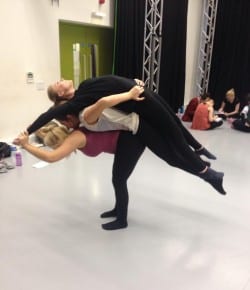Reading a similar sourcebook as last week, by the same author Woodhull, it helped me further my research about the giving of weight and centre of balance. The reading this week was intriguing as it was based on a paralysed mans view of contact improvisation. The reading opened my mind to ideas of how I can give my weight in various ways. And to also take weight with not just my legs and back but also other structured and stable body parts such as my stomach. ‘keep your eyes open don’t get lost in your head’ (Woodhull, A, 1998, 157), This quote sparked my attention. It allowed me to think about looking for opportunities to support my partner and to take weight without listening for agreement. Being aware and focused is crucial during improvisation, as it allows you to find moments of uniqueness and surprising risks.
At the start of the workshop this week we watched two videos which allowed us to see different duets performing contact improvisation. However, the one that I felt intrigued me the most, was Otto Akkanen and Mirva Makine’s piece. Their routine was satisfying to the eye. Soft, not stiff. I was mesmerised by the fluidity of their lifts and their lifts were adventurous and precise. So much precision and effortlessness it almost looked choreograph. The video inspired me to develop my knowledge of contact improvisation further, wanting to create a piece were everything felt connected with a sense of thoughtlessness.
This week during the practical based workshop, we experimented with lifts going up as well as lifts going down. An example of this is the paper clip grip. Where the over dancer places their arm over the under dancers back. The under dancer grabs around their waist and lifts them onto their side. I felt this lift worked well to go up and back down, however, the lift didn’t create much height. This lift I feel could be more advanced in order to take a risk. We experimented with a rather difficult lift which required the over dancer balancing along the under dancers shoulder. This was rather exciting to try. However I was apprehensive to whether I would be able to lift someone in that way taking their whole weight. Surprisingly I found myself performing the lift with ease as well as relying on someone to lift me.
I found that when we performed a small jam at the end of the session everyone felt more relaxed and at ease with taking and giving weight. I felt adventurous as well as nervous as to whether the lifts would go to plan. Despite this, I decided to go into the lifts without thinking about the performance of them. This benefited the fluidity of the lifts allowing me to relax and to take my partners weight ant to be a supportive structure. Surprisingly I found myself being the over dancer rather than the under dancer, this I found strange as I’m usually more comfortable being the over dancer. But however I felt a great sense of trust with my peers. I left the Jam feeling impressed with everyone’s progress, and the ability to perform advanced lifts in an improvised setting.
